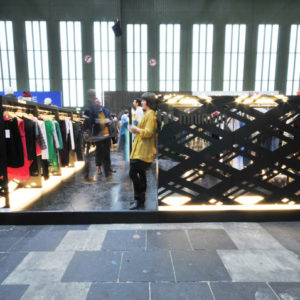


Installed at [storefront] Olson Kundig Architects, Mushroom Farm invited visitors to consider the far-reaching impacts of one seemingly simple lifestyle choice—purchasing a cup of coffee—as a nexus for sustainable awareness, community-building, and a model for future urban agricultural practice. While most coffee grounds enter a traditional waste stream after a barista pulls a shot, Mushroom Farm re-purposed them into a growing medium for oyster mushrooms.
The space itself was divided into two parts: the front half contained the twelve foot by sixteen foot mushroom growing tent, while the back half accommodated a twenty foot-long table made from reclaimed timbers for gatherings, lectures and lunches. The ribs of the growing tent were made from reclaimed plywood from used concrete formwork that would have otherwise ended up in a landfill; metal conduit functioned as shelves and held the 215 mushroom-growing bags.

Olson Kundig Architects and CityLab7, a Seattle-based group of collaborators who received grants from Invoking the Pause to explore issues related to climate change around the subject of food, worked closely to develop the concept for the installation. Mushroom Farm was on view at [storefront] Olson Kundig Architects February 21, 2012 through March 23, 2012.
With Mushroom Farm, [storefront] Olson Kundig Architects continued its series of exploratory installations and social practice experiments, this time through a collaboration with CityLab7, a Seattle-based group of collaborators who received grants from Invoking the Pause to explore issues related to climate change around the subject of food. “We ask our collaborators what they can do in our space that they couldn’t do elsewhere?” said Alan Maskin, who, along with fellow principal/owner Kirsten Murray, directs the activities of [storefront].

Olson Kundig Architects and CityLab7 worked closely to develop the concept for the installation, as well as with Schuchart/Dow, the general contractor who led the fabrication and sourcing of the donated construction materials. Members from all three organizations teamed up to build the structure.
The space itself was divided into two parts: the front half contained the twelve foot by sixteen foot mushroom growing tent, while the back half accommodated a twenty foot-long table made from reclaimed timbers for gatherings, lectures and lunches. Olson Kundig and Schuchart/Dow worked together using building information modeling (BIM) software to determine the most efficient configuration for cutting down the donated materials. The University of Washington College of Built Environments permitted the team to use its CNC machine (a Computer Numerical Control device) for precision cutting and fabrication.

Made from reclaimed plywood that would have otherwise ended up in a landfill, the ribs of the structure also functioned as shelves that held 215 mushroom growing bags. The structure was wrapped with a layer of heat-sensitive plastic sheeting; after the quick application of a torch, the plastic became taut, creating a cocoon-like form through which visitors can walk. Mushroom Farm was on view at [storefront] Olson Kundig Architects February 21, 2012 through March 23, 2012.
Photographer: Kevin Scott

http://www.olsonkundigarchitects.com














